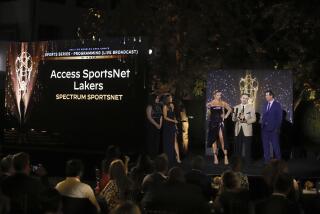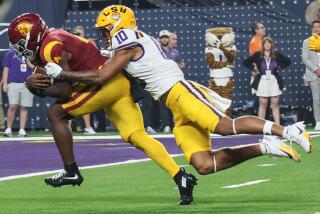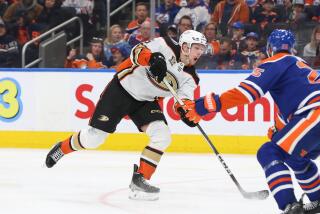NHL Endures Remote Outpost
- Share via
The NHL, returning from a season lost to a lockout, needed a cable TV outlet that would give it star billing instead of the bit-player status it had received at ESPN.
OLN, known as a hunting-and-fishing haven during the lulls between Lance Armstrong’s Tour de France triumphs, wanted to change its image from a quaint and quirky sportsman’s paradise to a home for testosterone-fueled competitive sports.
And so was born an unlikely partnership between the NHL, desperate to grab a chunk of a fragmented TV audience, and OLN, known as the Outdoor Life Network when it was known at all beyond its narrowly focused, heavily male audience. So far, their alliance has had some on-air missteps and is producing feeble ratings, but neither side is measuring success by conventional standards.
Their convergence, sealed in August with a deal that’s worth $135 million over two years and could last three or six years depending on a variety of options, occurred at a pivotal time in their history.
Plagued by weak TV ratings and an unappealing, defense-oriented game, the NHL had been forced to accept a profit-sharing deal for over-the-air telecasts on NBC. When ESPN declined to pick up a $60-million option for this season but suggested it might consider a profit-sharing model -- and then declined to match OLN’s offer -- the NHL took its puck home.
League executives said they felt insulted by ESPN, which had used hockey to establish its legitimacy. They wanted ESPN’s cachet but wouldn’t grovel for it. Their cable package “was probably undervalued before that, and we were not prepared for further undervaluing of the product,” said Bill Daly, NHL deputy commissioner.
Enter OLN, owned by cable giant Comcast, which owns a two-thirds stake of the Philadelphia Flyers. Under Gavin Harvey, a UCLA business school graduate who had a marketing background and became OLN’s president in March 2004, the network had moved away from its outdoorsy roots by adding the Dakar Rally, Iditarod, America’s Cup yacht race, Boston marathon and reruns of CBS’ “Survivor” series.
“Our mission at that point was to start to expand the middle,” Harvey said. “To get people to watch as destination, people who don’t know the difference between carbon fiber and titanium as a benefit to your bike or couldn’t argue entomology for fly-fishing.
“We need more men, for more minutes, more often. And they don’t have to be hikers or bikers or campers or hunters. They just have to be guys. Who are the guys watching the NFC championship? Because it’s a big event? I want those guys watching our programming.”
The NHL gets in on the beginning of a dream, much as it did on ESPN. OLN, which plans another name change next year to reflect its wider aim, gets to piggyback on the NHL’s history and mainstream status while still giving its core fans mano-a-mano battles. Instead of man vs. beast, as in its Professional Bull Riders events, or man against the sea, it’s shooter against goalie.
“The evolution of OLN was a big part of what we talked about,” Daly said. “The most important part was they were prepared to make us a priority, which I think they’ve done.”
Harvey declined to say whether OLN will use the NHL as a foothold to pursue TV rights of other sports leagues, but that’s not farfetched.
“We have never said that we want to take on ESPN because ESPN is a great channel. It’s an institution,” he said. “It’s simply that we’ve been trying to make this channel better. Our distributors have asked for it, our advertisers have asked for it. Viewers are responding to it.”
Perhaps so. But not in huge numbers. And the NHL is discovering that being a big fish in a small pond has its drawbacks.
OLN reaches 63 million homes; ESPN goes to 90 million and ESPN2 to 89 million. In addition, OLN was dropped by Cablevision for several weeks at the start of the hockey season, eliminating about 3 million homes, and OLN remains off EchoStar’s Dish network because of a dispute over EchoStar’s placement of OLN on a higher-priced channel package. OLN pulled its NHL telecasts because that channel isn’t seen by 40% of the system’s viewers, the minimum set by OLN for providing games.
OLN is delighted with its internal viewer measurements. Compared to a year ago in the same time periods, it has more than doubled impressions among its target groups of men 18 to 34, men 18 to 49 and men 25 to 54. Overall numbers, though, are small. Its first NHL telecast drew a 0.4 rating and 353,439 households and didn’t return to that level until Nov. 16. Through the same period of the 2003-04 season, ESPN averaged a 0.5 rating and 476,384 households, and ESPN2 averaged a 0.2 rating and 196,000 homes.
However, ESPN2’s telecasts were not exclusive, meaning they were not seen in the markets of the teams involved. OLN telecasts are seen in the local markets, which account for nearly 80% of OLN’s national audience. Without the local markets, OLN’s ratings would be microscopic. Through last week, they were averaging a rating of 0.24, slightly down from a 0.3 last month.
“We’re getting numbers that are very comparable to ESPN last year. We anticipate the numbers will get better as we build a relationship with them and as viewers know where to look for the NHL,” Daly said. “Next year they will have exclusive windows where they will have the only game. With proper lead time, we can build a schedule around our broadcast partners.
“The timing was not ideal. We signed the agreement six weeks before the season was to start and signed with a network that had never done a major sports league. It continues to be a work in progress and we’re pleased with the progress Comcast and OLN are making.”
Marc Fein, OLN’s senior vice president for programming and production, called hockey the network’s “crown jewel,” adding, “On the distribution side it helps elevate OLN into a must-have network,” although he said that “in a couple of months, in straight-up profit and loss terms, you can’t assess” the deal’s impact.
Harvey said OLN is “impatient for growth” but happy with results so far. “We’re starting to see OLN is less and less the story and the NHL and the game is the story,” he said. “It’s a new network, and again, everybody was, ‘What’s it doing on that network?’ They didn’t quite get the connection. Hockey fans found it right away.
“I think you’ll get the bigger growth as more and more people are attracted to the game and the heavy lifting the league and players have done by getting the game back on the ice. That’s what we’re sort of starting to see, and when the games are really good, the fans are coming. And again we’re only in the first couple of months. It’s just back. It’s a question of people finding us, getting reconnected with their teams, getting reconnected with some of their favorite players who have moved to other teams, and a question of our distribution.”
Viewers who found OLN’s first few telecasts often had trouble hearing the fuzzy audio feeds. The set for the intermission shows, with ESPN recruit Bill Clement as host, looked like something assembled in a garage by a bunch of kids on a rainy day. “I couldn’t figure out if I was going to go bald or gray first,” Fein said of the audio woes. “It was upsetting. We felt terrible.”
Harvey acknowledged that “there were definitely things we’re not proud of that were going on” and attributed the technical problems to a rush to get on the air. He said the set will be improved and telecasts will be enhanced with player profiles and other efforts to “demystify” the sport and its athletes. OLN aired its first doubleheader last Monday and ventured west of the Central time zone for the first time; it plans several more doubleheaders and additional games involving West Coast teams.
“One of the issues in televising hockey is that there’s so much in-arena excitement that doesn’t always translate to television. Of all the majors, it’s toughest to translate the speed and athleticism,” Fein said.
“Fox, NBC and ESPN are all very good networks with a lot of talented people. Our hope and intention is that we can grow it to that higher level over time.”
Harvey said he’s sure that day will come.
“I think now we are in the good part,” he said. “We definitely turned the corner.”
More to Read
Go beyond the scoreboard
Get the latest on L.A.'s teams in the daily Sports Report newsletter.
You may occasionally receive promotional content from the Los Angeles Times.







